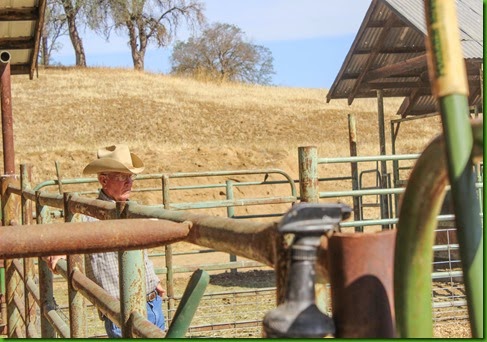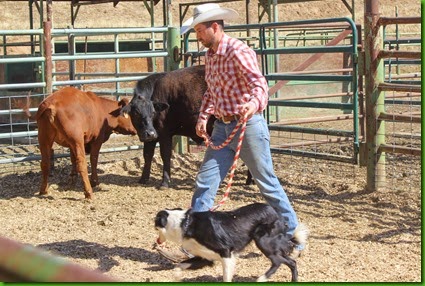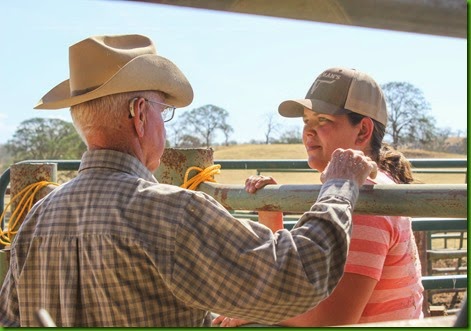I told Shannon and Dustin about my goals and how I was very eager to join and help them in any way possible at their Parkfield ranch, and so a date was set (last weekend). I didn’t know much about their property or the intended experience except that I figured it was going to be a gather, some vaccination and care, and loading up some cattle to go to market.
First, you have to understand my expectations. When someone describes a ranch in Parkfield, here’s what I think, having driven by a few times:
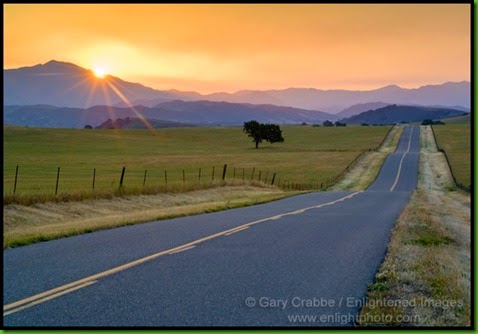
Pretty, right? But like . . . rolling hills, wide open expanses, not much.
I also heard that they had a Basque shepherd tending the place, and from my experience there, this even more doubled my expectations, because my experience about Basque shepherds in California is remote, bland hillsides and run down little trailers.
I’d seen some field work Shannon had done with the dogs via video and there were some trees but I was NOT truly prepared for this:

And that’s not even half the ranch in view.
There’s this:

And that still isn’t all of it. I think they said 5000 acres – enough to get lost in. Enough to lose 200 head of cattle in, that’s for sure.
I wanted to know what real ranchwork in the West took and how dogs fit into that, and know it, I do. This isn’t Scottish Border Collie land with big, wide pasture, no siree bob.
Oh, and that trailer I was imagining that we’d be staying in?

This is its front patio. No big. Sleeps 22. There’s a Viking range in the kitchen.
Now, before you think that the Woods are super fancy all hat, no cattle, this is a family hunting ground purchased by his parents and uncle that he took 8 ragged little cows and built up a herd on, putting in improvements on the way. They are super blessed to have had the land to start with, but they’re hard working, visionary kids . . . and they’re younger than me.
In fact, everyone on this trip was younger than me, which was a first. It’s also really interesting because being super aware of this, the vision they had for the future surely was a bit different with regard to the stockdogs than the “old guard” tends to put out.
Besides Shannon and Dustin, there were the Valdez brothers, whom Dustin has known since elementary school. Luis was the big talker, Gilbert and Abel the quiet ones. I loved when Abel said at some point, “I don’t talk much, but when I do, it’s the truth!”
Anyway, Luis is a professional horse trainer, and he had along four border collies that were quite different from the Woods’ ones. “They’re all rejects – given to me,” he said. And his approach to how to use them was different. I never got to see his dogs work because they’d gone up ahead of us to gather because rain was in the forecast, but from described, they do group work that’s a bit Western, but controlled.
When we got to putting Rippa on cows the second day, he was MORE than impressed with Shannon’s dogs, whom she was controlling on command and with them both together flanking in opposite directions like a perfect brace.
He watched me work Rippa and when we were talking about all the things running in my head (and if you read this blog, you don’t need a synopsis), he put it this way:
“It’s like horses, right? You can have a $200 horse or a $20,000 horse and they cost the same to feed them. It just depends what you need them for. Of course, you can take the $20,000 horse and win back the money.”
Luis’s dogs were free. I don’t know how much she paid for Cat, but let’s say it’s closer to the $20,000 horse range in this scenario. Where’s Rippa? Somewhere in the middle.
So, let’s get to that.
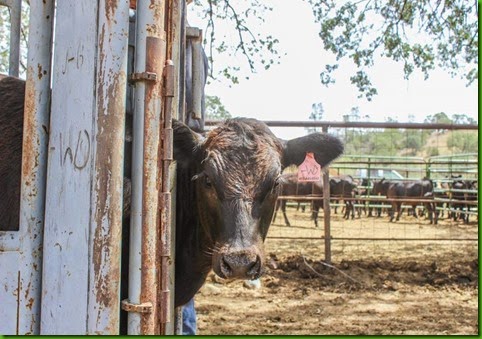
The first day we were there, we set to counting out the weanlings and putting them through the chute to vaccinate and treat injuries or what have you. Once that was done, everyone loaded their trailers full of cattle and drove 45 min one way out of the ranch to load into pens for the semi to come get them in a couple days.
When we got back, Shannon suggested I give Rippa a shot at moving the cows that had been separated from their calves out of the holding pen and out to the field where the guys had dropped hay.
What this means is that the cows were pretty much headed that way anyway so as long as Rippa had herself under control, it was going to be a successful job.
I don’t need to go into details, but we got it done and she was pretty nicely receptive to everything I asked from her. Shannon was on one side helping until we we got further along the fenceline toward the hay and up the hill where she couldn’t see us. This part, of course, was the best. By this point (we’d been working 5-10 minutes) all the cows were going the right way and Rippa was thoughtfully looking after the stragglers and pushing them in the direction of the rest of the cows. It was a really good work. I could see that she’d be really useful doing this kind of work right away. When she got to the top of the hill almost out of my sight, she stopped and waited, and I saw that she’d gotten them all down to the feed hay and was waiting to see what was next.
”That’ll do.” I felt pretty good about that. I can definitely drive cattle along a fenceline with her, and even make a couple mistakes and clean the up as a team, without help from Shannon or her dogs.
The next day we had a rare and light rain storm, but had to wait it out because the mountain soil is bad for driving or doing anything in, really. Once it cleared, everyone went down to the pens so that Rippa could have a shot at open field work. Shannon and Cat got a herd of 20 or so together in the hay field we’d left them in earlier and Luis sat down and we went to work.
It was like a roller coaster. Rippa went out, but cut in too tight, got them together, then lost me and went through them, if one cut off, she’d go hard after but then kind of come up short and drop them . . . and the draw to the holding pens with the rest of the cows was pretty strong, too.
Shannon would use Cat and Zeta to set them up, and then we’d kind of mash through them like bowling pins. I got really frustrated. This wasn’t cool. I got exasperated and Shannon said it looked like her driving instincts were kicking in instead of the fetch.
Luis said we should stop trying to direct stuff and let her just figure it out.
And here is something I’ve been working out all this time, right? Somewhat resolved for me.
I think Luis is mostly right. If I hadn’t been hell bent on not breaking my dog and getting nice outruns and good commands, and just let Rippa work it out over a period of time, she’d probably figure it out. But it’s a period of time and a sloppy job. And I’ve ben training for a non-sloppy job right off the bat. I can’t let it be sloppy midway through and wreck my arena training.
But that’s totally good enough for this ranch hand, right? I mean, Luis actually did some impressive work according to Dustin.
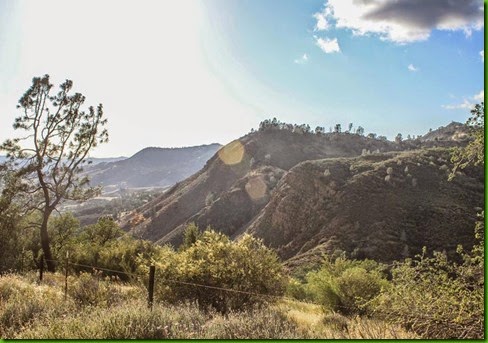
See this range here? Apparently they were missing some pairs, and Luis had a dream they were in the canyon on the far right of this shot. He went out there with two dogs at night and sure enough, they were. But, the way the land was, he had to drive them across all those mountain faces and THEN down to pasture land and the road. While Luis likes to talk, I have no reason to distrust Dustin on this, and if he did it by himself with two dogs, those free dogs were good enough for me.
And, honestly? Again, we go back to how dogs are raised and used, but if I had a need like that, I know that Rippa and I could get ‘er done. I know this because this kind of terrain is what Fury and I would lose Doug MacDonald’s sheep in all the time, and even though Fury’s kind of ruined for trialing, she did that job just fine. It wasn’t perfect and I didn’t have a lot of control on it so it took more time than I’d like, but it got done.
I think about Nathan, too, from Adelaida Ranch with Maya? (Remember when I went out there and they set up a round pen for training but the sheep weren’t broke enough for me to get anything done?) He doesn’t have any formal training on her, but he figured out how to use her and loves her.
Okay, back to the work.
Because of the draw and how things were going, I couldn’t really get to Rippa on foot to push her back and get her out, so I suggested taking it to horseback. They worked out a spot to try it all at that was flat (right in front of the cabin) so we could do good work with Rippa.
It went as well as could be expected, I think. Rippa was psyched and felt a little out of control, she wasn’t used to me placing her on horseback (so next time I ride with the dogs, I need work on my obedience) and my horse was a little squirrelly under me (Shannon says it’s me, and I believe her, I haven’t been riding a lot lately and only just started again after a 20 year break), so if I did get close enough to correct her, the horse was going to run her over. :/
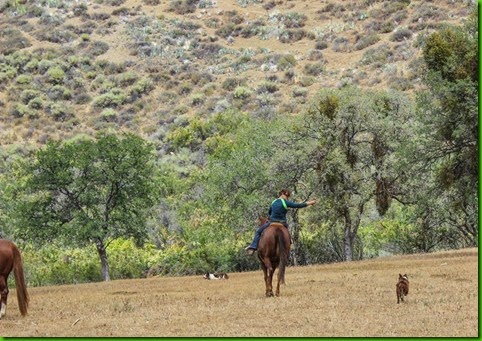
“Away, out!”
I asked Shannon to let Cat and Zeta help her like Kathy used to do and Betty did with Spur, and that got Rippa in the right frame of mind after a bit.
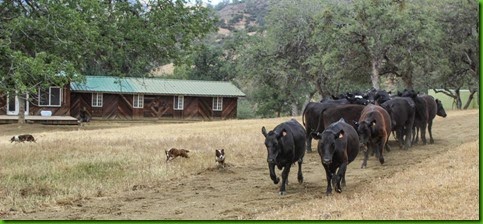
Here’s why stuff didn’t go so well down below and here – it illustrates flight zone SO well, too. There’s Rippa on the right, and she’s heading straight at the cow’s eye – which isn’t stopping her, but pushing her, and she’s heading hard. Zeta, to Rippa’s left, is watching the eye and arching out to catch it in front of the cow. Cat, way left, is heading WAY out of the scene to back up Zeta.
Rippa basically ran this cow off and then gave up when she knew she couldn’t catch her.
We had some good stuff, too, though:
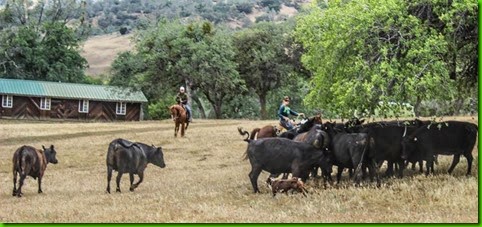
Here’s Rippa headed out to the loose cattle there to tip them back in.
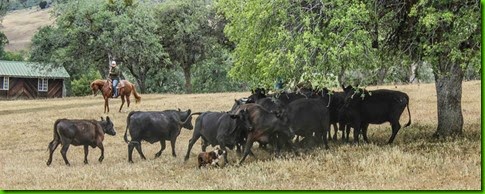
And now here’s Rippa heading back, the two strays heading in the right direction . . . but wait, why are those cows going the wrong way? WHERE AM I, ladies and gentlemen? Behind that tree, pushing them that way. Poooooor Rippa.
You know what we’re good at? Driving – with me out of the picture.
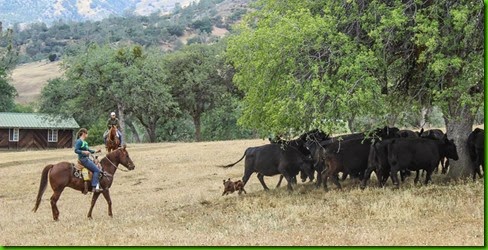
Of course, I was so worried about Rippa, I stopped worried about my effect on the cows and was basically just running them off, like a boss.
I’ve GOT to abandon the training mindset with this stuff and just think about where I want the cows to go and show Rippa I have her back. Shannon tells me this all the time, and I think it’s what causes Rippa to give up when I don’t.
So, we put Rippa up and Shannon suggested I try to work Cat, but she wasn’t having it. Luis volunteered and so we took them through a course as a team. He was the one taking photos so we don’t have that. Luis was a nice dog, I tell you what, but I was a much better handler, too. The courses aren’t like ASCA, though, right? It’s more about using eachother, so I was affecting the cows on horseback as much as Luis the dog was.
Then Shannon suggested I do it just myself and the cows and had me on a course so I’d be watching them and thinking about that.
In the end, it was interesting hearing Luis’ opinion as an outsider with a bit of a different perspective than Shannon’s, though pretty much nothing different from her’s:
“You will do really well if you can stop worrying about your dog so much.”
This led to some interesting discussions:
How Shannon thinks you really need to start with a broke dog (aka, finished) and learn how to handle that way so you have good habits and understand the picture, vs being a beginner multitasking (me worried about the horse, the cows, and the dog). I think she’s absolutely right. It would not have taken me as long as it has had I started learning how to handle and whatnot with a finished dog. And you know what? I had the opportunity. Kathy totally let me use her BC/Aussie cross Stingray for lessons for a while when I first showed up with my dog Dusty who had no instinct, but I didn’t get what the point was then and I don’t think she told me, so I quit and didn’t go back until I had the Fury, who was a LOT of dog for a beginner anyway.
That’s kind of the point of me handling Cat before we go to work with Rippa in the arena now. To get me in the right mindset. Rippa does really well when I’m not super worried about the outcomes.
I have to be honest, I was so upset about how that work went, but I also had to remember that Rippa’s never had this opportunity before, I didn’t know what I was doing, and . . . yeah, all the excuses in the world, I know, but I think they’re valid. Most trial Aussie people don’t do what I was trying to do until their dogs are WTCh’d or in finals.
Oh, and let’s go there for a second. I always knew that Kathy was training you for a totally useful dog rather than the trials, but it wasn’t until this trip that I realized WHY I had to stop letting us cheat on some things like wide outruns. Because you need them. In an arena setting, I can let Rippa go straight to her stock and start driving. She doesn’t NEED to go out wide, nor do I think it does anything at all to help her.
Does she have instinct to go WIDE? Errrr, yes and no. Fury has always worked WAY wider, so no, there. Will she work wide? When Rippa calms down, she backs off. So, my job is to give her confidence to calm down. I didn’t do a great job of that starting her because I was all nervous about her. I’m only just now learning to trust her, and in this case I didn’t and THAT didn’t work, DID it.
So, could she be naturally wider? Yes. Can I have messed it up a bit? Also, yes.
So I talked to Shannon about what her dogs look like when she gets here and puts them to work for the first time, and she says they’re pretty useful right away. “Whatever you see in the arena, you generally see it here, too.” Which, OMG lightbulb, right? Thinking bigger picture when evaluating your stock and now I see what the point is.
Of course, why are they more useful? They don’t all have a natural instinct to stay off stock more – I’ve seen a lot of her started dogs and while they have a different style, the main difference to me is in the biddability/training. (Shan may disagree.) That’s not an Aussie thing, though. Fury is super biddable. The more confident Rippa becomes, the more biddable she is. But her dogs also got trained by someone who understands the bigger picture completely when she starts, she’s trained more of them, she’s more consistent with less bad habits.
OMG EXCUSES! I hear it, I know!
But here’s the thing Shannon and Dustin have been in this game for only five years and they win. And their dogs are nice. And their dogs do real work. And people underestimate them because they’re all in and they’re successful this quick. So, baby, Shannon’s got a point.
So what’s my takeaway?
- Rippa doesn’t suck. She wasn’t the golden God of stockdogging, but it would be stupid to expect it. She’s not a $20,000 horse. But she’s not the free horse, either. I have to admit having Luis watch us do it was intimidating, but I wasn’t embarrassed by what she did – she had power, bite, speed, she had instinct and didn’t fear the cows . . . and that’s a lot of what’s missing in Aussies that people complain about, and in other dogs, too. I’m pretty damn happy with her because the longer I do this, the more I see the handicaps involved, too. I feel like a lot of what’s lacking is because of training and experience, not necessarily the dog herself. AKA – I have not been convinced that I have to switch to border collies, despite all the encouragement that way. Shannon always says I’d be SO much farther along and how fun would it be to have the lines to breed together and etc, but you know what? I like being the underdog. I got Aussies because they were rare at the time. I got working Aussies because I wanted to know what that is about. And I am trying to focus on ranching Aussies because that’s where the need is for this breed. I want every Rancher who likes Aussies but’s given up on them to know there’s an option and no need to give up. That’s the goal. And I’m ready to say that, yes, I am excited for the next generation to start that way and get better and better. And I want to use Rippa to get there.
- Is Rippa more a driving dog? Was Leslie Means right that Aussies don’t have a strong fetch? There are books that say they are, and there are breeders/trainers that say so, too. Are some lines specifically more driving than not? Or is it all training and experience? I think I need to see/work with more dogs to say.
- New, clearer training goals: I have got to fix Rippa’s outruns and effectively get her calmer when she feels out of control. I’ve been working more on controlling her speed and it’s working, but now I need to go back and fix those two. Doing that will help with trials, but it will also make her a more useful ranch dog. Once I get that, I think we can get the balance we need. I don’t think Rippa has a lot of natural balance to her – that’s a big difference in Shannon’s dogs and my own dogs that I’ve handled. That’s something I need to bring in genetically. Not having to train that would help with both of these things.
- I took these lessons well and have already applied them. When we got back and I was waiting for the huz to pick us up, Dustin suggested I go work Rippa with the arena cows and it looked really really good. Dustin caught sight and shouted that it looked that way, too. Part of this was due to the Ben Means video, so an update on that is coming up. Part of it was also all the lessons on when to trust her, when not to, and to work on outruns and stuff. But she was pretty dang nice in there.
And, finally, in the beginning, I said that I was in a younger crowd and that the mindset about stockdogging was different than what the old guard presents. The old guard thinks the use of a stockdog is waning, but Luis and Shannon were talking about how it has the potential to get bigger – with the trials and the more and more refined training techniques, how obvious it is to have a good stockdog and how much cheaper in the long run it is . . . this is your next generation cowboy and cattlemen, and they get it.
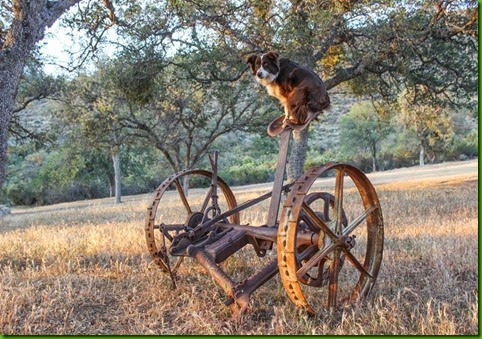
If you’d like to see more photos from the weekend,
I have a public Facebook album.












